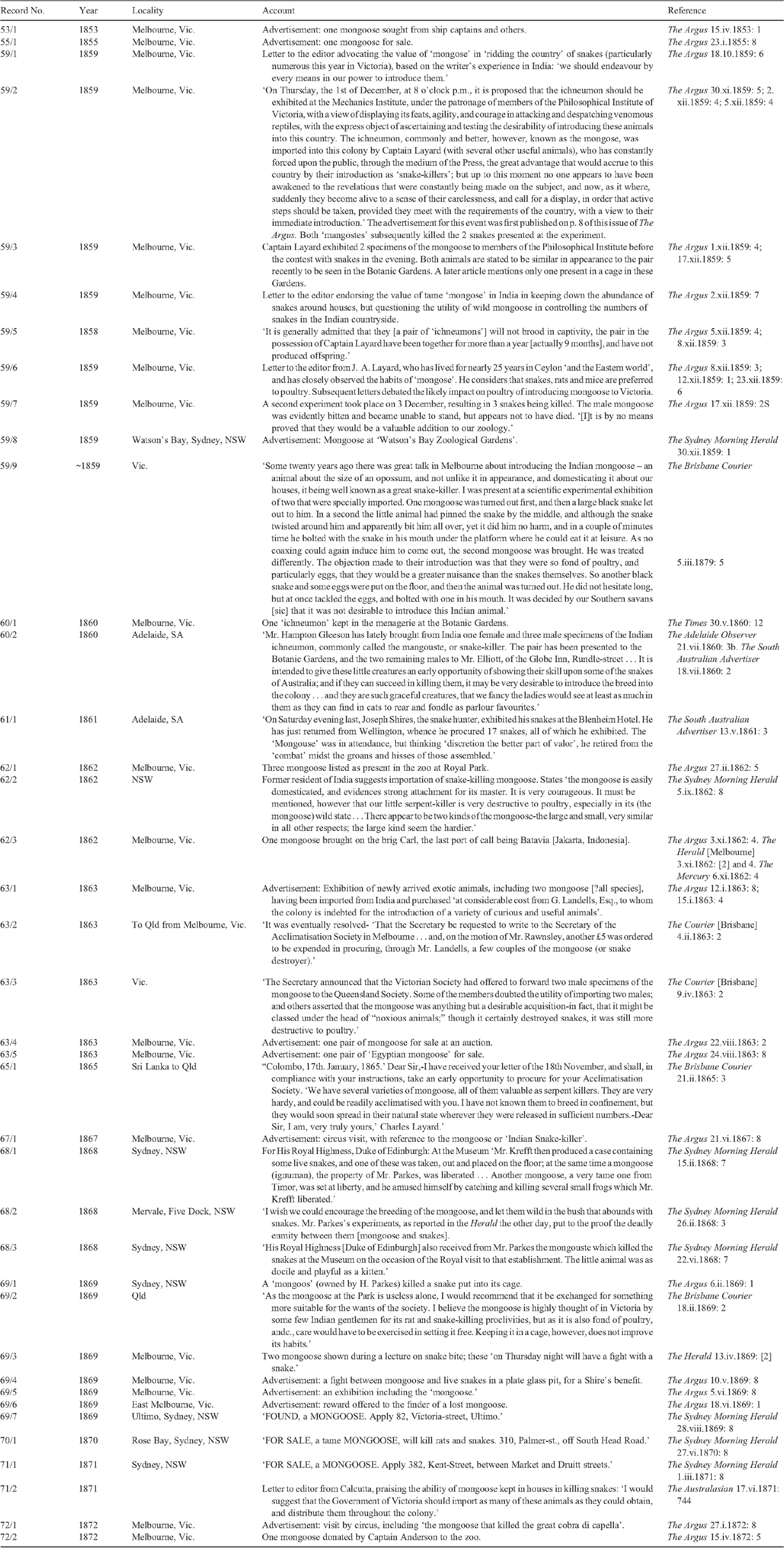The mongoose in Australia: failed introduction of a biological control agent
David Peacock A C and Ian Abbott BA Natural Resources Management Biosecurity Unit, Biosecurity SA, GPO Box 1671, Adelaide, SA 5001, Australia.
B School of Earth and Environment, Faculty of Natural and Agricultural Sciences, The University of Western Australia, 35 Stirling Highway, Crawley, WA 6007, Australia and Science Division, Department of Environment and Conservation, Locked Bag 104, Bentley Delivery Centre, Bentley, WA 6983, Australia.
C Corresponding author. Email: david.peacock@sa.gov.au
Australian Journal of Zoology 58(4) 205-227 https://doi.org/10.1071/ZO10043
Submitted: 17 June 2010 Accepted: 7 September 2010 Published: 13 October 2010
Abstract
We reviewed historical literature and obtained nearly 200 records of the mongoose in Australia up to 1942. Although the earliest importations (from 1855) were for its snake-killing prowess, often as entertainment, its perceived potential as a control agent for the European rabbit (Oryctolagus cuniculus) plague saw concerted introductions made in New South Wales, Victoria and South Australia, primarily in 1883 and 1884. At least 1000 mongoose were released to control rabbits at 14 reported release locations in these states. As many as 700 of these mongoose were reported released in one New South Wales rabbit-control trial. These numbers indicate that insufficient propagule pressure does not explain why Australia escaped the additional devastation of an established mongoose population. The only reason stated for the failure of the mongoose releases to control rabbits is destruction of the mongoose by rabbit trappers, both inadvertently and in seeking to protect their employment. Unfavourable climate was implicated by CLIMATCH modelling in the failure of all releases, especially those into semiarid areas such as western New South Wales. No contemporary detail could be located of the reported 1884 failed introduction of ‘numbers’ of mongoose into North Queensland to control rats in sugarcane plantations.
Additional keywords: biocontrol, bounty, Herpestes, Oryctolagus cuniculus, pest, rabbit.
Acknowledgements
We thank: Staff at the State Library of South Australia, particularly Joyce Garlick, for procuring requested mongoose accounts; David Stemmer, South Australian Museum, and Sandy Ingleby, Australian Museum, for providing details of mongoose specimens held in their care; Mary Bomford for reviewing our CLIMATCH analysis and commenting on the manuscript; and Win Kirkpatrick and Marion Massam, Western Australian Department of Agriculture and Food, for running a comparative CLIMATCH analysis – obtaining results similar to those presented in this paper.
Abbott, I. (2002). Origin and spread of the cat, Felis catus, on mainland Australia, with a discussion of the magnitude of its early impact on native fauna. Wildlife Research 29, 51–74.
| Crossref | GoogleScholarGoogle Scholar |
Anonymous, (1884). Untitled. Nature 30, 345.
Cockerell, T. D. A. (1901). The mongoose in Jamaica. Nature 63, 348.
| Crossref | GoogleScholarGoogle Scholar |
Espeut, W. B. (1882). On the acclimatization of the Indian mungoos [mongoose] in Jamaica. Proceedings of the Zoological Society of London 1882, 712–714.
Hays, W. S. T. , and Conant, S. (2007). Biology and impacts of Pacific Island invasive species. 1. A worldwide review of effects of the small Indian mongoose, Herpestes javanicus (Carnivora: Herpestidae). Pacific Science 61, 3–16.
| Crossref | GoogleScholarGoogle Scholar |
Peacock, D. E. (2009). The grey squirrel Sciurus carolinensis in Adelaide, South Australia: its introduction and eradication. The Victorian Naturalist 126, 150–155.
Simberloff, D. (2009). We can eliminate invasions or live with them. Successful management projects. Biological Invasions 11, 149–157.
| Crossref | GoogleScholarGoogle Scholar |
Veron, G. , Patou, M.-L. , Pothet, G. , Simberloff, D. , and Jennings, A. P. (2007). Systematic status and biogeography of the Javan and small Indian mongooses (Herpestidae, Carnivora). Zoologica Scripta 36, 1–10.
| Crossref | GoogleScholarGoogle Scholar |




